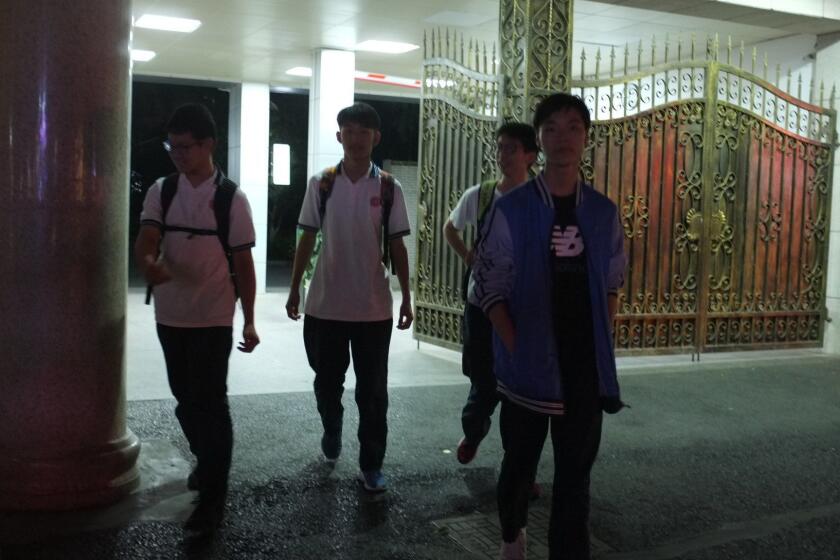How China cornered the facial recognition surveillance market
- Share via
What do Uganda’s police force, a Mongolian prison and Zimbabwean airports have in common? All three are in the process of testing facial recognition systems and all three have used Chinese technology to do it. At least 52 governments are doing the same thing, according to research by the Carnegie Endowment for International Peace.
Chinese facial recognition companies have taken the lead in serving this growing international market not least because of the advantage they have over peers in other countries: a massive domestic market and an authoritarian system where privacy often takes a back seat. According to IHS Markit, China accounted for nearly half of the global facial recognition business in 2018.
“There are protests around the world from Lebanon to Chile and Iraq, and a lot of these governments, whether it’s liberal democracies or more autocratic, are in tenuous positions,” says Steven Feldstein, a fellow at the Carnegie think tank. “Now, there is technology available that allows them to fight back against political mobilization.”
Critics and human rights campaigners have accused Beijing and the surveillance companies of “exporting authoritarianism” via the technology that has been used at home as part of a security crackdown that has led to the detention of more than 1.8 million people, predominantly Uighur Muslims, in the Xinjiang region.
China is tracking gamers and punishing young players for “excessive” playtime — with the help of American companies, including Riot Games.
Chinese companies may be the most successful, but they are not the only ones supplying surveillance technologies to governments. Rivals from Israel, Japan and America are competing to do the same, while often sourcing components from the U.S.
Research by Feldstein into the global expansion of artificial intelligence surveillance found that Chinese tech companies — particularly Hikvision, the world’s biggest surveillance camera vendor, Huawei, Dahua and ZTE — have supplied countries ranging from Australia to Myanmar and Kazakhstan.
“These companies are particularly well-suited to provide” advanced surveillance capabilities, says Feldstein, “but also they are willing to go to markets that perhaps Western competitors are less willing to go to.”

On the roads leading into Nairobi, the Kenyan capital, surveillance cameras flash at every car passing in and out of the perimeter of the urban center, capturing and analyzing the identities of their occupants. Chinese telecom company Huawei boasts that its cameras led to a 46% drop in the regional crime rate in 2015. Local government figures suggest the impact was smaller, and only short-lived.
The company, which was blacklisted for allegedly posing a threat to U.S. national security this year, has supplied surveillance equipment — including facial recognition — to roughly 230 cities worldwide, stretching from western Europe to large swaths of Asia and sub-Saharan Africa. It supplies more countries with artificial intelligence video surveillance than anyone else, according to Carnegie.
“Huawei has been investing heavily in the developing world in a way their telecom provider competitors haven’t. It is perfectly pitched for surveillance projects,” says Henry Tugendhat, a researcher at Johns Hopkins School of Advanced International Studies. “The governments have an interest in security and companies have an interest in selling.”
But the question of who is driving the surveillance rollout is not straightforward.
“I would beware of the idea that Africa is a blank slate, where the Chinese arrive bringing their oppressive ways,” says Iginio Gagliardone, author of “China, Africa, and the Future of the Internet.” “Companies are spinning their products to fit the political demands of African elites.”
Hikvision, which grew out of a government research institute but is now only partially state-owned, has a growing international presence, supplying video surveillance infrastructure from Brazil to South Africa and Italy. It is one of a clutch of Chinese tech companies — along with Dahua, SenseTime and Megvii, among the world’s leading artificial intelligence software vendors — to have been blacklisted by Washington over alleged involvement in supplying technology used in Xinjiang.
At first, it just seemed cool.
Yet Chinese domination of the market shows no sign of waning. According to figures from IHS Markit, China’s market expanded by 13.5% last year, whereas the global market — excluding China — grew by just 5%. In 2017, Chinese state media boasted that the country had built the world’s biggest video surveillance system, employing more than 20 million AI-enabled cameras.
Chinese companies have previously operated under loose regulation at home and abroad, but are now facing challenges from the public unhappy at the expansion of facial recognition. Some 80% of respondents in the country’s first mass survey on the issue, released on Thursday, feared data leaks from facial recognition operators.
“When you’re arguing with public bodies like the Beijing subway about their use of facial recognition, there’s no point talking to them about data protection,” Hong Yanqing, a scholar at Peking University, told a recent forum in Beijing. “Instead we need to have a debate about the appropriateness and proportionality of using” facial recognition.
Hong helped draft the government working group’s report on personal data protection standards.
The widespread use of facial recognition in China is in part a reflection of how many activities already require real-name identification. Face scans have replaced or augmented human identity checks in hotels, flights and trains, and at banks and hospitals. Regulations, which came into effect last week, require telecom carriers to scan the faces of users registering for mobile phone services.

But facial recognition is also being used to extend surveillance in new ways, such as tracking the classroom behavior of students. The country’s rapidly expanding network of facial recognition cameras means many people are now subject to mass identification. China’s police force already holds the world’s biggest national database of more than 1 billion faces, captured for the national ID card system. Depending on the quality of these photos, they can be matched to people posing for a face scan.
The industry is beginning to pay attention to the complaints. SenseTime announced last week that it will lead a consortium of 27 companies to help set national standards for facial recognition, under the guidance of a government standards body. “The public is increasingly paying attention to the security problems faced by this technology,” the company wrote in a social media post.
While debate over the use of facial recognition in the European Union and the U.S. is focused on the privacy threat of governments or companies identifying and tracking people, the debate in China is often framed around the threat of leaks to third parties, rather than abuses by the operators themselves.
China’s courts received their first challenge to the commercial use of face scans in October. When a zoo in Hangzhou forced season pass holders to submit to face scans for entrance, Guo Bin, a professor at Zhejiang Sci-Tech University, sued the zoo in order to keep his personal information private. Face traits are “sensitive personal data,” he said in a court submission, arguing that the data could be leaked or stolen.
Most Chinese people approve of the use of facial recognition for convenience and improving security, but remain concerned about privacy abuses, according to Beijing’s Nandu Personal Information Protection Research Center, which conducted the mass survey.
The installation of an in-class facial monitoring system at China Pharmaceutical University in Nanjing in September sparked widespread online criticism. As part of a new “smart campus” system, the school installed face scanners in two classrooms to track attendance and to catch students dozing, playing on their phones or talking in class. It “effectively solves the difficult problems of managing attendance and low efficiency,” the school says.
In response, China’s education ministry said the department would add restrictions and regulations on the use of facial recognition in schools, and hoped they would be “highly cautious” in using the technology.
The city of Suzhou, known as “the Venice of the East” for its web of intricate waterways, captured the imagination of Marco Polo when he journeyed through China more than seven centuries ago.
While Chinese companies are dominant in the global facial recognition market, their position is coming under pressure from rivals such as Japan’s NEC, which supplies similar technology in 14 countries, and IBM, the software company Palantir and Cisco in the U.S.
“Companies from other countries including Israel and Russia are very advanced in this space, and are making a play in markets such as the United States and regions in the Caucasus and Central Asia, which is significantly under-reported,” Feldstein says.
Israeli companies like AnyVision and Elbit Systems have supplied technology to the U.S., while Ukrainian start-up Riddletag uses Amazon’s facial recognition technology to allow access to passengers in the Tbilisi subway in Georgia.
“U.S. companies, for all the lip service they pay to technology and ethics, are also building surveillance tech, and indeed supplying Chinese companies that produce it,” says Stephanie Hare, an independent researcher of facial recognition technology and ethics, and a former employee of Palantir. “This leaves everyone else with a decision: be spied on by the U.S. or by China? This point was made in the German parliament last week, and the U.S. was very upset about it, saying there can be no moral equivalence between China’s authoritarianism and U.S. values.”
Meanwhile, China’s surveillance industry is already moving on to the next frontier of computer image recognition: identifying people by the way they walk and trying to read their emotions.
© The Financial Times Ltd. 2019. All Rights Reserved. FT and Financial Times are trademarks of the Financial Times Ltd. Not to be redistributed, copied or modified in any way.
More to Read
Inside the business of entertainment
The Wide Shot brings you news, analysis and insights on everything from streaming wars to production — and what it all means for the future.
You may occasionally receive promotional content from the Los Angeles Times.













